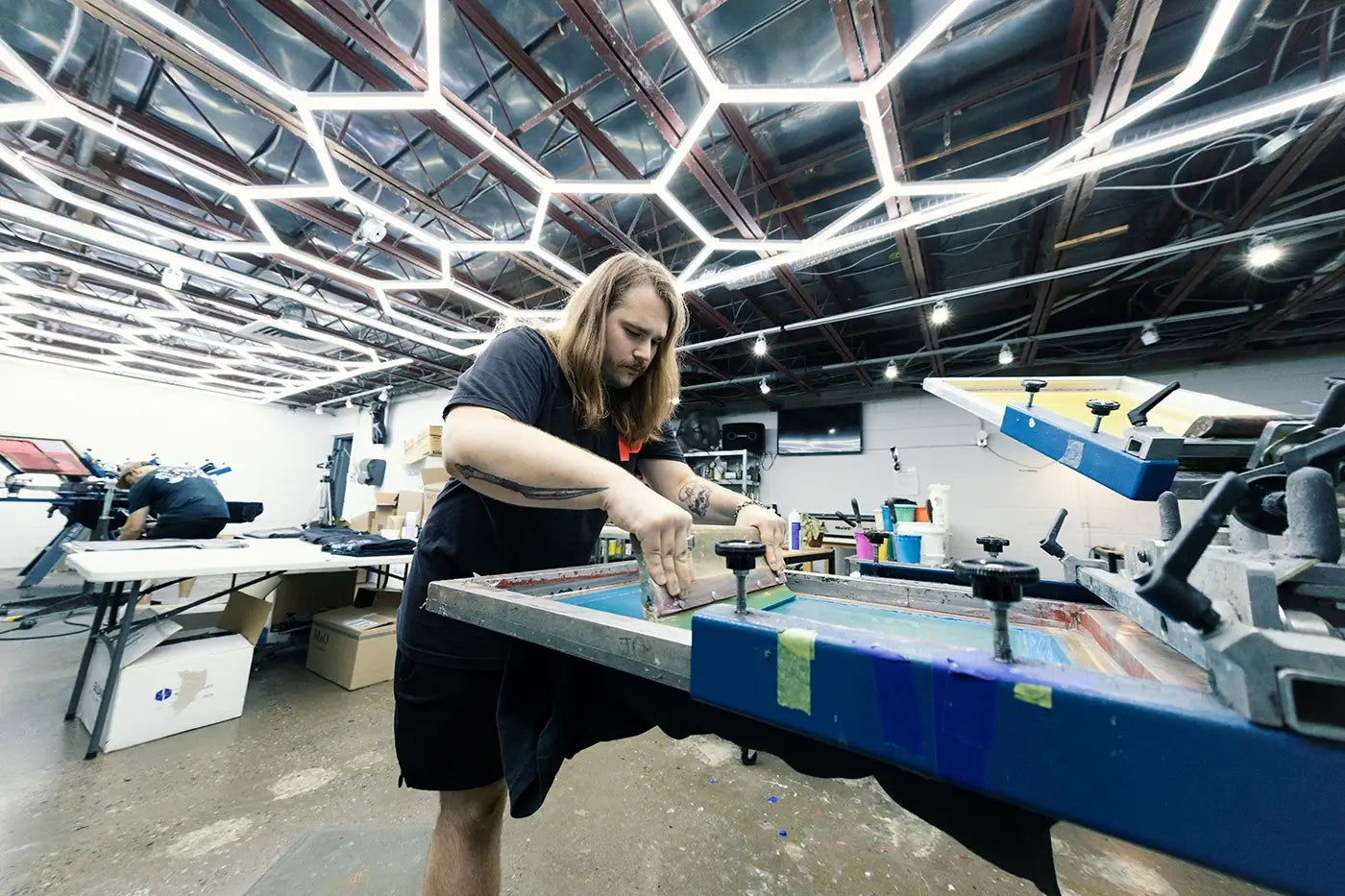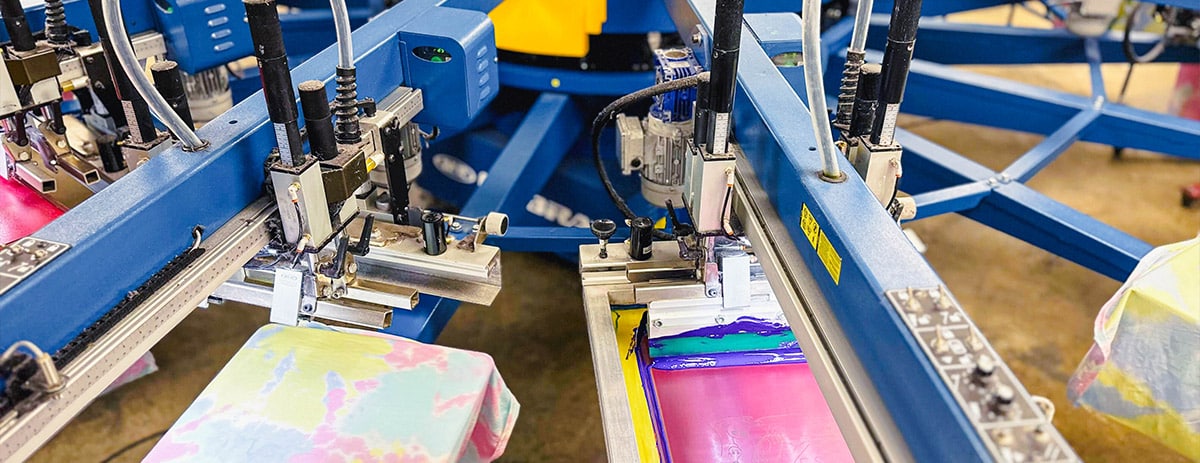Best Local T-Shirt Printing for Personalized Apparel
Best Local T-Shirt Printing for Personalized Apparel
Blog Article
Screen Printing Uncovered: Every Little Thing You Required to Understand About Tee Shirt and Garment Printing Methods
If you've ever asked yourself exactly how those dynamic designs wind up on your favored tee shirts, you're in the ideal place. Screen printing is an interesting method that combines art with technique, providing countless possibilities for creative thinking. Recognizing the fundamentals, from tools to ink options, can significantly influence your results. All set to discover the important aspects that make screen printing an art kind? Allow's discover the information that can raise your projects.
The Essentials of Screen Printing: Just How It Works
When you dive right into display printing, you'll uncover it's both a science and an art. At its core, screen printing includes producing a pattern, or screen, that allows ink to go through only in certain locations (screen printing kit). You start by picking your style and preparing your display with a light-sensitive solution. When you expose this solution to light, it sets, leaving your design as a negative room.
Setting the screen over the fabric, then make use of a squeegee to push ink via the display onto the garment. Each action is vital, and understanding them will raise your display printing skills, transforming straightforward garments right into one-of-a-kind, expressive items.
Sorts Of Screen Printing Techniques
Once you grasp the basics of screen printing, it's time to explore the numerous methods that can boost your styles. One prominent approach is standard display printing, where ink is pushed via a stenciled screen. This strategy is terrific for vibrant, vibrant colors. After that there's water-based ink printing, which uses a softer feeling and is environmentally friendly, yet it requires a various method to treating.
If you're going for fine information, consider discharge printing. This technique eliminates dye from the fabric, leaving a soft, vintage look. Another option is plastisol printing, known for its resilience and vibrant colors, making it a preferred for lots of brands. Experiment with halftone printing to create gradient impacts and elaborate styles. Each technique has its special beauty, so don't be reluctant to try them out to find what suits your design best!
Important Equipment for Display Printing
To attain stunning results in screen printing, having the appropriate equipment is basic. You'll require a durable display printing framework, which holds the mesh that moves your design onto the garment. Next off, spend in premium squeegees; these are crucial for using ink equally across the display.
Picking the Right Inks and Products
When picking inks and materials for screen printing, you require to consider the sort of ink that works ideal for your job. Think of fabric compatibility to assure your layouts look last and wonderful lengthy. Discover eco-friendly ink options to make your printing procedure extra lasting.
Sorts Of Screen Inks
Selecting the appropriate display ink is important for attaining dynamic, resilient prints that meet your task's needs. There are numerous kinds of display inks to take a look at. Plastisol ink is popular for its flexibility and convenience of usage, giving superb shade opacity on dark fabrics. Water-based ink, on the other hand, provides a softer feeling and is environment-friendly, making it suitable for those seeking to reduce their environmental impact. Discharge inks remove color from the fabric, causing a soft, vintage look but require details handling. Ultimately, specialized inks, such as metallic or glow-in-the-dark, can add unique effects to your designs. Review your task demands and pick the ink that straightens ideal with your wanted result.

Fabric Compatibility Considerations
Recognizing textile compatibility is crucial for achieving premium display prints, especially because different materials react uniquely to numerous inks. Always examine your inks on example material to guarantee they stick correctly and preserve shade honesty. Additionally, keep in mind that fabric weight and appearance can impact the last outcome, so picking the ideal ink and material combo is important for your job's success.
Eco-Friendly Ink Options
Green inks are coming to be a popular choice for display printers who intend to lessen their ecological impact while preserving high quality. When picking inks, take into consideration water-based inks, which are less damaging and much easier to clean up contrasted to conventional solvents. These inks bond well with materials, providing vibrant outcomes without harmful chemicals. You may also check out eco-solvent inks that make use of less unstable organic compounds (VOCs), making them a much safer choice for both your wellness and the world.
Furthermore, look for inks made from renewable energies, such as soy or vegetable-based choices. By choosing the appropriate inks and products, you'll not just create stunning designs but also add to a more lasting printing procedure. Make the switch, and your prints will mirror your commitment to the atmosphere!
Preparing Your Design for Screen Printing

File Style Demands
To guarantee your style looks lively and sharp on textile, you'll require to pay close attention to file format demands for display printing. Make sure your style has a transparent background to protect against undesirable white edges on your prints. Maintain color modes in mind; CMYK is basic for screen printing, so convert your RGB creates accordingly.
Color Separation Strategies
Color splitting up is a crucial action in preparing your style for display printing, and understanding it can considerably enhance your print quality. You'll require to damage your design right into private shades, as each color needs a separate display during printing. Start by identifying all the shades in your layout and develop layers for each one. You can make use of software like Adobe Photoshop or Illustrator to isolate and separate colors efficiently. Be particular to save each layer as a separate file, usually in a layout like TIFF or PSD. This accuracy not only assures accurate shade representation however likewise enhances the printing process. By focusing on shade separation, you'll attain vibrant and specialist outcomes in your screen-printed garments.
Resolution and Size
Attaining the most effective results in screen printing begins with assuring your layout has the right resolution and dimension. Ideally, your artwork ought to be at the very least 300 DPI (dots per inch) for sharp, clear prints. If you utilize lower resolution, your final item could look amateur and pixelated.
When it involves size, think about the dimensions of your print area. Design your art work to match the last print dimension, preferably developing it in the actual dimensions you'll be printing. This method, you'll avoid any unforeseen scaling problems.
Constantly check your layout in both vector and raster styles. Vector graphics can be scaled without losing quality, making them optimal for screen printing. Preparing properly will guarantee your design looks amazing on every garment!
Step-by-Step Screen Printing Process
Screen printing is a vibrant process that enables you to create lively layouts on various surfaces. To obtain begun, you'll require a screen, solution, and your chosen ink. Initially, prepare your screen by cleaning it thoroughly. Next, use the emulsion evenly and let it dry in a dark area. When completely dry, subject your display to light with your style put on it, which will solidify the emulsion where the light hits, creating a pattern - screen printing kit.
Pour ink onto the display and make use of a squeegee to push the ink via the pattern onto the material. Lift the display very carefully and allow the print completely dry. You've successfully screen printed your design.
Tips for Successful Display Printing Projects
While you're diving into your screen printing projects, keep in mind that prep work is essential to success. Begin by gathering all your products-- inks, displays, garments, and mops. A tidy workspace aids avoid unwanted errors, so clean up prior to you begin.
Next, validate your art work is high-resolution and properly sized for your garment. Check your screen for correct exposure and tidy it thoroughly to prevent smudges. When mixing your inks, adhere to the producer's guidelines to accomplish the best consistency.
During printing, use also pressure with your squeegee for regular outcomes. Do not hurry; take your time to confirm each print meets your criteria. After printing, allow your garments dry totally prior to managing or packaging them.
Last but not least, always maintain a sample of your benefit future recommendation. By doing this, you can analyze your progression and boost your techniques in time. Pleased printing!

Regularly Asked Concerns
For how long Does It Take to Establish a Display Printing Work?
Establishing a display printing job typically takes about thirty minutes to an hour. You'll prepare the screens, custom screen printing mix inks, and change the press. The time varies based upon complexity and experience, so stay organized!
Can I Print on Various Textile Enters Using the Exact Same Technique?
Yes, you can publish on various material types utilizing the same strategy, but you'll require to readjust your inks and setups. Some textiles soak up ink differently, so experimenting guarantees the very best outcomes for each material.
What Prevail Blunders to Avoid in Display Printing?
When display printing, prevent common mistakes like utilizing the wrong ink, disregarding appropriate direct exposure times, or avoiding pre-press checks. Constantly examine your setup and maintain tidy displays to ensure high quality results each time.
How Can I Properly Tidy and Keep My Display Printing Equipment?
To appropriately clean and maintain your display printing devices, you ought to routinely clean displays with ideal solvents, inspect mops for wear, and assure all tools are kept dust-free and completely dry. Uniformity improves and prevents costly repair work performance.
Is Display Printing Eco-friendly Compared to Other Techniques?
Screen printing can be more eco-friendly than other techniques, particularly if you make use of water-based inks and eco-conscious materials. By choosing lasting products and methods, you minimize waste and reduce your influence on the earth.
Display Printing Uncovered: Whatever You Need to Know Regarding Tee Shirt and Garment Printing Methods
At its core, screen printing includes developing a stencil, or display, that permits ink to pass with just in particular areas. Placement the display over the material, after that make use of a squeegee to press ink via the display onto the garment. One preferred method is conventional display printing, where ink is pushed through a stenciled screen.When choosing inks and products for display printing, you need to take into account the type of ink that works ideal for your job.
Report this page